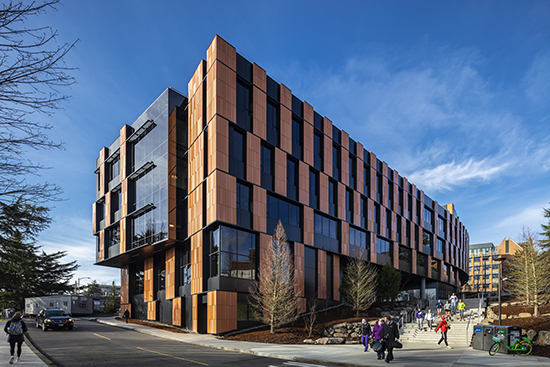|
Subscribe / Renew |
|
|
Contact Us |
|
| ► Subscribe to our Free Weekly Newsletter | |
| home | Welcome, sign in or click here to subscribe. | login |
Construction
| |
 |
April 5, 2019
Light-Gauge Steel Framing Washington

University of Washington Bill & Melinda Gates Center for Computer Science & Engineering Building (Phase II)
Location: Seattle
Contractor: Enderis Co.
Architect: LMN
Team: CWallA, CertainTeed Gypsum, Foundation Building Materials, HILTI, Scafco Steel Stud Co., Spears Construction Supply, USG Building Systems
According to Enderis, the Gates Center was the pinnacle of 30 years of experience in the wall and ceiling industry. The project was extremely detail-oriented and presented a multitude of unique challenges.
The project had large amounts of different types of perforated acoustic gypsum wallboard from different manufacturers, each with its own non-traditional finishing techniques. Each type required extensive research, special components, and specialty-access panels.
The shape of the project alone was one of the greatest challenges: think of a football with the ends cut off. Grid lines were radiused and even perpendicular walls were radial, like spokes on a wheel. Traditional layouts were not an option, leading Enderis to learn new technology, a GPS-type of total positioning system for site layout.
The precision offered by the total station was such that it proved valuable in discovering errors by the site surveyor on at least 10 occasions. Enderis became instrumental in pointing out dimensional flaws that not only saved time and money but proved to be a valuable asset to the general contractor.
The building had another unique component: balloon framing, where exterior walls were framed from slab to slab, then scabbed onto the exterior of that framing. This was critical because the exterior finish panel at the balloon framing was terracotta. Enderis was able to assist in developing functional deflection details overlooked in the design. They created seven mockups with seven different caulks, and finally came across the right product for the job. No one will ever notice this joint again except the architect, the general contractor and Enderis — which was the intent.
Juror's comment: “It was like the entire building was built with radius framing. The final effect is astounding.”
Other Stories:
- Interior/Commercial • Washington
- Light-Gauge Steel Framing Oregon
- Renovation/Restoration/Commercial • Oregon
- Suspended Ceiling/Commercial • Oregon
- Exterior/Commercial • Oregon
- Interior/ Commercial • Oregon
- Exterior/Residential • Oregon
- Residential • Oregon
- Renovation/Restoration/Residential • Washington
- Suspended Ceiling/Commercial • Washington
- Exterior/Commercial • Washington
- Interior/Residential • Washington
- Exterior/Residential • Washington
- Exterior Renovation Commercial • Washington


